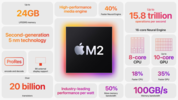Google Tensor G2 vs Apple M2
Google Tensor G2
► remove from comparison
The Google Tensor G2 SoC is a chip that was developed by Google and Samsung for the Google Pixel smarthpones. It is the successor to the Google Tensor G1 and still integrates the same CPU cores. This processor part includes two fast ARM Cortex-X1 cores at up to 2.85 GHz (up from 2.8 GHz of the G1), two mid-range Cortex-A78 cores at up to 2.35 GHz and four small ARM Cortex-A55 efficiency cores with up to 1.8 GHz. The caches are identical with 4 MB CPU L3 cache and 8 MB system level cache. Therefore, the CPU performance is very similar to the first generation of the Tensor SoC.
A big upgrade is the new TPU, which should be more powerful and power efficient compared to its predecessor. In our tests, the AI performance is about 50% higher.
The iGPU was also improved, and now uses a more modern ARM Mali G710 architecture with 7 cores.
The chip also integrates a Titan M2 security processor, a LPDDR5 memory controller, and an ISP for 10-bit HDR / 4k/60 video and 108 MP cameras.
The SoC is manufactured in 5nm at Samsung.
Apple M2
► remove from comparison
The Apple M2 is a System on a Chip (SoC) from Apple that is found in the late 2022 MacBook Air and, MacBook Pro 13. It offers 8 cores divided in four performance cores and four power-efficiency cores. The big cores offer 192 KB instruction cache, 128 KB data cache, and 16 MB shared L2 cache (up from 12 MB). The four efficiency cores are a lot smaller and offer only 128 KB instruction cache, 64 KB data cache, and 4 MB shared cache. The efficiency cores (E cluster) clock with up to 2,4 GHz, the performance cores (P cluster) with up to 3,5 GHz and therefore higher than the M1 cores. The architecture should be similar to the A15 (iPhone 13) with Avalanche and Blizzard cores.
The chip features a unified memory architecture for the CPU and GPU cores and supports up to 24 GB LPDDR5-6400 for a bandwidth of up to 100GB/s.
According to Apple, the M2 offers a 18% higher CPU performance at the same power consumption level compared to the Apple M1. In our tests, the MacBook Pro 13 with active cooling was able to reach the 18% in Geekbench Multi. In other benchmarks we measured 12 to 15% gains compared to the M1. Therefore, the performance is now near the M1 Pro with 8 cores. The passively cooled MacBook Air may however suffer from throttling in longer load scenarios.
The integrated graphics card in the M2 offers 8 or 10 cores and a peak performance of 3.6 TFLOPs.
Furthermore, the SoC integrates a fast 16 core neural engine with a peak performance of 16 TOPS (for AI hardware acceleration), a secure enclave (e.g., for encryption), Thunderbolt / USB 4 controller, an ISP, and media de- and encoders.
The Apple M2 includes 20 billion transistors (up from the 16 billion of the M1) and is manufactured in the second generation 5nm process at TSMC (most likely N5P). The power consumption is rated at 20W what we also measured under CPU load.
| Model | Google Tensor G2 | Apple M2 | ||||||||||||||||
| Codename | Cortex X1 / A76 / A55 | |||||||||||||||||
| Clock | 1800 - 2850 MHz | 2424 - 3480 MHz | ||||||||||||||||
| L3 Cache | 4 MB | 8 MB | ||||||||||||||||
| Cores / Threads | 8 / 8 | 8 / 8 | ||||||||||||||||
| Technology | 5 nm | 5 nm | ||||||||||||||||
| Features | ARM Mali-G78MP20 GPU | ARMv8 Instruction Set | ||||||||||||||||
| iGPU | ARM Mali-G710 MP7 | Apple M2 10-Core GPU ( - 1398 MHz) | ||||||||||||||||
| Architecture | ARM | ARM | ||||||||||||||||
| Announced | ||||||||||||||||||
| Manufacturer | store.google.com | www.apple.com | ||||||||||||||||
| Series | Apple M2 | |||||||||||||||||
| Series: M2 |
| |||||||||||||||||
| L1 Cache | 2 MB | |||||||||||||||||
| L2 Cache | 20 MB | |||||||||||||||||
| TDP | 20 Watt | |||||||||||||||||
| Transistors | 20000 Million |
Benchmarks
Average Benchmarks Google Tensor G2 → 100% n=11
Average Benchmarks Apple M2 → 224% n=11
* Smaller numbers mean a higher performance
1 This benchmark is not used for the average calculation












